5 Considerations for Your ISO20022 Migration Project
Over the next years, the world of payments will change forever because of the introduction of ISO20022, a standard for electronic data interchange between financial institutions. The migration using CBPR+ is part of an initiative to create a single standardisation approach for all financial standards initiatives. With the aim to have a new global standard for payments.
Financial institutions worldwide have now until 2025 to complete the migration, replacing the existing MT format and becoming fully compliant with the new protocol. ISO20022 will substantially automate payment processing and will change the way banks send cross-border payment instructions. The transformation will be of a comparable magnitude to the SEPA transition or the introduction of the Euro.
In terms of adoption, the Eurosystem's TARGET2 system will also adopt ISO 20022 for high-value payments as of November 2022. The Bank of England's RTGS system will complete the 1st phase of the migration by June 2022 while the Federal Reserve's FedWire and other Market Infrastructures will also follow. It’s now time for those operating in the financial services industry to start seriously planning around this.
What are the main points that financial institutions should keep in mind for the ISO20022 migration?
1. Senior management engagement in the process
Here we are talking about a point that's fundamental to understand. People make companies, and every significant project in a company starts from its people's commitment. It's true for digital transformation as it's true also in this case. But the engagement should start from the upper management, with decisional power, to give an example and show the rest of the employees the importance of this process for the whole organisation and make everyone feel involved.2. The broad impact that goes beyond payments
While it's natural to associate ISO20022 with the processing of electronic payments and cross-border payments, it is something with a broader impact. The migration is going to affect several divisions of the banks, including, for example, trade finance, treasury, and the securities departments.
3. Complexity, importance and fit into the global strategy
This point is strictly connected with the first two. The senior management involvement is fundamental to ensure that the migration fits into the global transformation strategy of the company. At the same time, it's essential to recognise the broad implications of this process on the various departments, to comprehend the potential complexities and plan accordingly. Given the substantial value and extent of the migration for payments processing and other functions, it would be a serious mistake to undervalue its complexity.
4. Time and costs
Let's get it straight, it's a process that depends on the path that organizations take, it could take some time to complete. While operators will continue to have the option to send and receive messages in either Swift MT or ISO20022 format for the near future, the MT messages will be then wholly decommissioned in November 2025. It’s a serious matter and financial institutions trying to minimise their ISO 20022 compliance are likely to face higher costs because of the risk of losing business customers. But also because they won't assess anti-money laundering (AML) and counter-financing of terrorism (CFT) counterparty risks with the same attention of institutions that are fully committing to the new standard.
5. Pick the right tools and select the right partners
A good percentage of financial institutions still rely heavily on legacy systems that could be highly complex and expensive to update to meet the new requirements. Picking a partner that can offer a proven solution including different messaging protocols with seamless integration in the existing infrastructure, is the most efficient and cost-effective way to complete this migration. That's why at PaymentComponents, we thought about creating specific products to help our clients find simple solutions to complex problems related to this transition. With the launch of FINaplo Financial Messages, we can now provide a disruptive tool for the future of payment solutions, allowing institutions to accelerate the financial messaging system's development and validation dramatically. But there’s more because with aplonHUB we provide a quick and cost-effective solution allowing banks to accept ISO20022 messages, eliminating the need to upgrade their entire core system, to meet the new requirements while keeping disruption to a minimum. It sounds interesting, right? If you need any help with this migration, you know where to find us!

